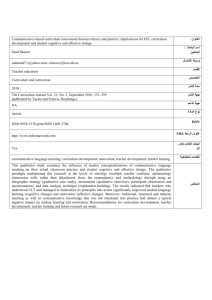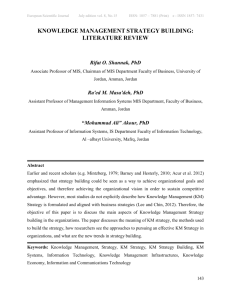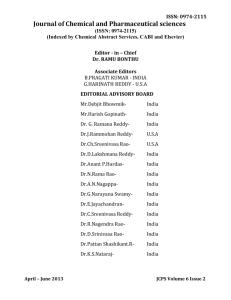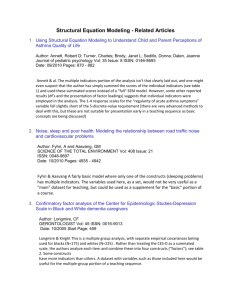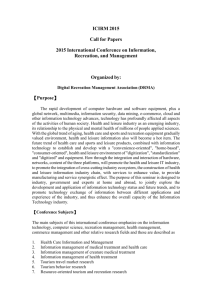organizational internal communication as a
advertisement
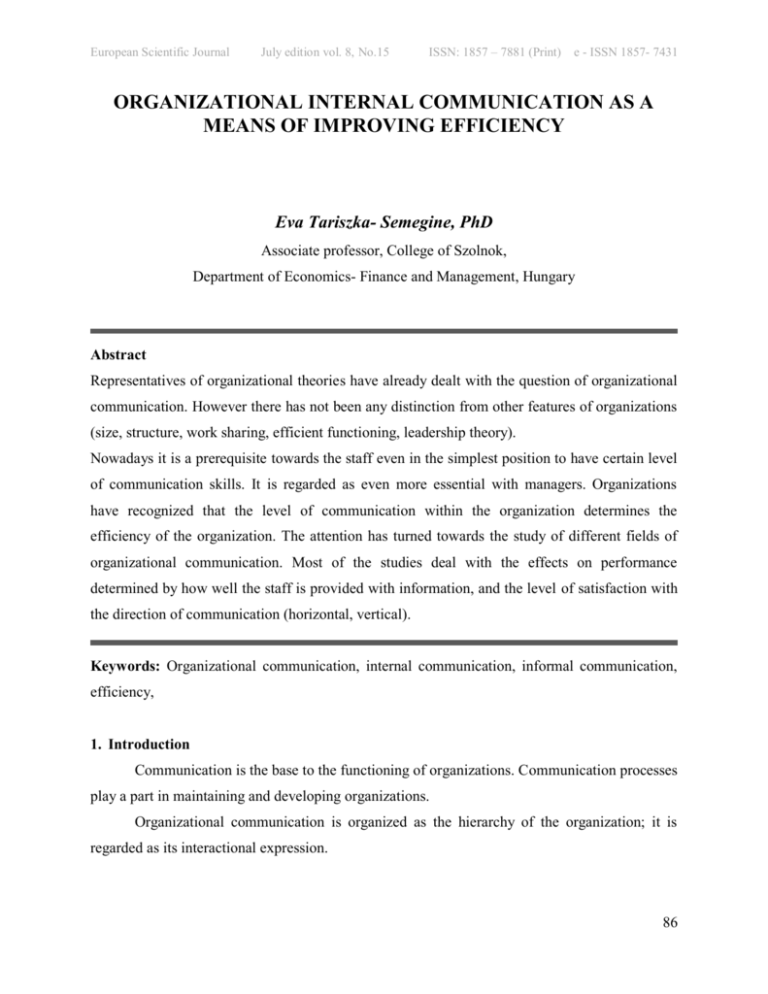
European Scientific Journal July edition vol. 8, No.15 ISSN: 1857 – 7881 (Print) e - ISSN 1857- 7431 ORGANIZATIONAL INTERNAL COMMUNICATION AS A MEANS OF IMPROVING EFFICIENCY Eva Tariszka- Semegine, PhD Associate professor, College of Szolnok, Department of Economics- Finance and Management, Hungary Abstract Representatives of organizational theories have already dealt with the question of organizational communication. However there has not been any distinction from other features of organizations (size, structure, work sharing, efficient functioning, leadership theory). Nowadays it is a prerequisite towards the staff even in the simplest position to have certain level of communication skills. It is regarded as even more essential with managers. Organizations have recognized that the level of communication within the organization determines the efficiency of the organization. The attention has turned towards the study of different fields of organizational communication. Most of the studies deal with the effects on performance determined by how well the staff is provided with information, and the level of satisfaction with the direction of communication (horizontal, vertical). Keywords: Organizational communication, internal communication, informal communication, efficiency, 1. Introduction Communication is the base to the functioning of organizations. Communication processes play a part in maintaining and developing organizations. Organizational communication is organized as the hierarchy of the organization; it is regarded as its interactional expression. 86 European Scientific Journal July edition vol. 8, No.15 ISSN: 1857 – 7881 (Print) e - ISSN 1857- 7431 The efficient management of the internal processes of an organization is an essential factor in the competition. It is important that all the departments and staff be informed in time and in the right manner about what they should know for the efficient work. The improvement of the inner working efficiency means savings and it makes a profit. A company can be well characterized by the development of its internal communication. The way the communication channels is designed gives a picture of the company culture. 2. Organizational Communication Organizational internal communication according to Scott Cutlip’s (1985) definition should identify, create and maintain mutually beneficial connection between the organization and its staff whom its success and failure depends on. According to another definition (Bevan and Bailey, 1991) internal communication is such a process, in which an organization shares its information, builds commitments and manages the changes. As the main factor in the motivation and performance of staff, communication plays an important part in the competitiveness of the organization. In the practice of organizations internal communication is understood as part of the leadership function. Internal communication as a field of the work of the organization is made and changed in the work connection among the members of the organization. International eras of Organizational internal communication: Dover (1964) identified three eras of internal communication. The first is “ Dealing with the employee” which was popular in the 1940s. The 50s were characterized by “informing the employee” and 60s by “persuading the employee”. Grunig and Hunt named the 70s and 80s the era as the symmetrical internal communication or in other words “starting a communication with the staff”. 2.1. Levels Of Organizational Communication - interpersonal - on the level of groups - on the level of the organization 87 European Scientific Journal July edition vol. 8, No.15 - between organizations - mass communication ISSN: 1857 – 7881 (Print) e - ISSN 1857- 7431 Many authors classify micro, mezzo and macro levels. The micro level corresponds to the interpersonal level, the mezzo corresponds to the levels between groups or organizations, the macro corresponds to mass communication. Communication on the interpersonal and group level are on lower level than the one on the level of organization, yet they are the most important forms of communication within an organization, which is confirmed by the rich bibliography of organizational communication. Communication on the level of the organization focuses on the mezzo level. This view obviously suggests the opposition between the mezzo and micro. Proceeding from the micro to the mezzo we can introduce another level of differentiation, the formal-informal or verticalhorizontal level. 2.2. Formal Versus Informal In recent years the most important aspect of examining organizational communication for managers of big organizations has been the formal upward and downward communication. Informal communication has a connection to interpersonal, horizontal communication, mainly as a potential obstacle to efficient organizational production. It still cannot be identified clearly. The continuous, dynamic and not formal but informal communication is getting more and more important providing efficient management work in the modern organization. Papers written on informal communication emphasize that the management culture and atmosphere inhibits the confrontation of formal and informal communication. 88 European Scientific Journal July edition vol. 8, No.15 ISSN: 1857 – 7881 (Print) e - ISSN 1857- 7431 Figure1. Manager’s SAY/DO correlation associated with formal and informal communication conflict Adapted from D’Aprix(1996) D’Aprix(1996) developed a SAY/DO matrix as a key explanation of how informal/formal communication issues can arise. According to the latest studies the growing number of dynamically improving communication technology makes communication easier which is neither formal nor informal regarding communication within a group or a community. It can be formal/informal which is difficult to distinguish such as many new communication channels, which already exist in an organization and are neither formal nor informal but both at the same time. 2.3. Vertical, Horizontal Diagonal Communication Communication can be characterized as vertical, horizontal, or diagonal. Initially greater emphasis was directed at vertical organizational communication as compared to lateral communication. Diagonal communication is an even more recent emphasis in the organizational communication literature. 2.3.1. Vertical Communication Vertical communication occurs between hierarchically positioned persons and can involve both downward and upward communication flows. Downward communication is more prevalent than upward communication. Larkin and Larkin (1994) suggest that downward communication is most effective if top managers communicate directly with immediate 89 European Scientific Journal July edition vol. 8, No.15 ISSN: 1857 – 7881 (Print) e - ISSN 1857- 7431 supervisors and immediate supervisors communicate with their staff. A wealth of evidence shows that increasing the power of immediate supervisors increases both satisfaction and performance among employees. This was first discovered by Donald Pelz (1952) and is commonly referred to as the Pelz effect. Pelz was attempting to find out what types of leadership styles led to employee satisfaction (informal/formal, autocratic/participative, management oriented/front line-oriented). He found that what matters most is not the supervisor’s leadership style but whether the supervisor has power. One way to give supervisors power is to communicate directly with them and to have them provide input to decisions. Ensuring that supervisors are informed about organizational issues/changes before staff in general, and then allowing them to communicate these issues/changes to their staff, helps reinforce their position of power. When the supervisor is perceived as having power, employees have greater trust in the supervisor, greater desire for communication with the supervisor, and are more likely to believe that the information coming from the supervisor is accurate. Jablin (1980), after reviewing almost 30 years of research, pronounced the Pelz effect to be “one of the most widely accepted propositions about organizational communication.” Downwards communication According to Morgan and Shieman’s (1983) research in which 30,000 employee were asked, the majority of the employees felt that productivity was not better because of downward communication. The level of satisfaction got lower as we went down the organizational hierarchy. Foehrenbach and Rosenberg (1982) with the survey of 32.000 employees found quite a high level of satisfaction with downward communication. 71% stated that his/her organization informs its staff well 65% agreed that (s)he gets enough information for his/her work 51% agreed that downward communication was accurate and honest They also proved that employees want to hear more organizational news directly from the top management – this discovery was in conflict with the Pelz effect. In the end they found that employees require information from the top management in two major topics of interest – future plans of the organization and research and development. 90 European Scientific Journal July edition vol. 8, No.15 ISSN: 1857 – 7881 (Print) e - ISSN 1857- 7431 Figure 2. Hierarchy of employees’ communication needs Source: D’Aprix (1996) According to Jablin’s (1980) definition the best effect can be achieved with communication downwards if - Top managers communicate directly with immediate supervisors - Immediate supervisors communicate with their direct reports - On issues of importance, top managers follow-up by communicating with employees directly Perhaps the most tried and true rule of effective downward communication is to: Communicate orally, then follow up in writing (Gibson and Hodgetts 1991). Upward communication Even less is known about upward communication. One consistent finding is that employee satisfaction with upward communication tends to be lower than their satisfaction with downward communication. Researchers found low levels of satisfaction with all the strategies commonly used to enhance upward communication, including employee surveys, employee grievance programs, and employee participation programs such as quality circles and team meetings. Gibson and Hodgetts (1991) note several management-based reasons for this lack of satisfaction particularly 91 European Scientific Journal July edition vol. 8, No.15 ISSN: 1857 – 7881 (Print) e - ISSN 1857- 7431 that these strategies often do not involve two-way communication, are not packaged well, are poorly timed, and are apt to trigger defensiveness on the part of managers. In addition, McCelland (1988) found a number of employee-based reasons why upward communication tends to be poor, including: - Fear of reprisal – people are afraid to speak their minds - Filters – employees feel their ideas/concerns are modified as they get transmitted upward - Time – managers give the impression that they don’t have the time to listen to employees 2.3.2. Lateral Communication Lateral communication involves communication among persons who do not stand in hierarchical relation to one another. While recent trends to flatten organizations have enhanced the importance of lateral communications, studies on lateral communication still lag behind those on vertical communication. One fairly limited study found rather high levels of satisfaction (85%) with lateral communication among human resource managers, but lateral communication across managers of dissimilar functional divisions was often cited as a major source of organization dysfunction, It has been assumed that lateral communication at the worker level is less problematic, at least within a functional area. However, with the greater importance of teams, more attention is now being directed at communication between team members. Lateral communications between workers in different functional areas is also becoming a bigger concern as greater attention is being directed at increasing the speed of production through simultaneous, as opposed to sequential, work processes. And there is greater emphasis on communication across distributed workers and geographically separated work groups doing similar kinds of work in an attempt to promote learning and the sharing of expertise, best practices, and lessons learned. 2.3.3. Diagonal Communication Diagonal communication refers to communication between managers and workers located in different functional divisions. Similarly to vertical and horizontal communication, diagonal communication has also become important. The concept of diagonal communication was introduced to capture the new communication challenges associated with new organizational forms, such as matrix and project-based organizations. Thus with the growth of new 92 European Scientific Journal July edition vol. 8, No.15 ISSN: 1857 – 7881 (Print) e - ISSN 1857- 7431 organizational forms the research of communication processes has been expanded with diagonal direction too. 3. The Problem Of Measuring Efficiency Efficiency is the main problem of organizational work. On the fields where market has immediate effect, economy has created a great deal of methods to be able to analyze the result of investments with the help of comparing different indicators. The most well-known from these is the analysis of profit. The analysis of stock, turnover capital, the efficiency of work and other costs, but a series of comparative analyses appear which show the relationship in different fields, companies, sectors, national economies, and cash flow shows similar directions. How effective is internal organizational communication? Probably no one doubts that efficiency in the question of information flow lies in the speed of problem solving, the identity of coming to terms with problems and the organizing competence. In other words information should be available at the right time and the right place. ( Farkas, 2002.) This is the condition which can never be met: - because with the development of society, the environment expands too, databases we can use grow too - because it will always be in someone’s interest to distort information - because we see the world according to our own need and interest - because we have such managers who are sensitive to certain information and keep it to themselves or change it out of self-defense. - because we rely in a large degree on information systems as far as technology is concerned One big filed of measuring efficiency is the so called organizational factors which includes the physical, technical and technological factors. The other big field is the analysis of human resources abilities, competences, experience. The efficiency of organizational communication is directly affected by the organizational conditions. Organizational opinion however means a lot of problems, because in the world of modern organizations because it is and can be about the identity of individual and organizational interests, needs and aims. The employee –an organizational person, who is satisfied if (s)he can 93 European Scientific Journal July edition vol. 8, No.15 ISSN: 1857 – 7881 (Print) e - ISSN 1857- 7431 identify with the standards, requirements of an organization and has the possibility to self development. The organizational factors in this case mean the starting conditions of the problem of efficiency measurement, and can be understood as what would happen if I changed them and where I have to change to be more efficient. 3.1. Effect Model Of Internal Communication The effect model of internal communication was worked out by W. Armbrecht (1992). 1st level - communication 2nd level - information 3rd level – motivation 4th level – integration 5th level - identification The starting point of the step by step process is communication, which is the prerequisite for the individual to judge its internal surrounding. Communication enables the flow and exchange of such information that originate from the organization. The employee is motivated by the knowledge gained with the possession of the information an it enables him/her to move higher in the hierarchy; to integration and identification. Most of the times managers identify working communication with internal communication, this way communication with the employee is made only in meetings, reports and workshops. The complete or partial lack of internal communication presupposes the following negative effects: losing confidence towards managers low level of identification high level of fluctuation spread of informal communication (gossip) Internal communication should be worked out and made it work based on the mission, philosophy, strategic goals of the organization. The implementation of the internal communication system requires a substantial investment with the organization, so the payback and efficiency are important factors. 94 European Scientific Journal July edition vol. 8, No.15 ISSN: 1857 – 7881 (Print) e - ISSN 1857- 7431 Planning the internal communication presupposes the steps of ongoing surveys and evaluation and with it the efficiency of the organization and the growth of production of the employees can be pointed out. All the organizations should recognize that internal communication is one of the last rations reserves of our era. (Bogner, 1990.) 4. Conclusion To sum it up the consciousness of the resource features of internal communication system is not at the level that would definitely require the introduction of organizational communicational system. The function of the communicational system is mainly and systematically to provide information in an adequate and integrated way within an organization. Its implementation naturally means cost to the organization, but is needless to say that information is also a commodity and as such the informational and communicational resources require taking them into account similarly to traditional resources. References: Armbrecht W.: Innerbetriebliche Public Relations, Opladen: Westdeutscer Verlag Arnott 1992. Bevan, R. – Bailey,J. :Lesley’s Handbook of Public Relations and Communication 1991. Bogner,Franz: Das neu PRdenken 1990. Cutlip, S.- Center, A.- Broom, G. : Effectiv Public Relations Prentice Hall, Englewood Cliffs 1985. D’Aprix, R. : Communicating for Change – Connecting the Workplace with the Marketplace. San Francisco: Jossey-Bass Publishers 1996. Farkas J.: Információs vagy tudástársadalom? Infonia-Aula Kiadó Budapest 2002. Foehrenbach, Julie, and Karn Rosenberg: How Are We Doing? Journal of Communication Management 12(1):3-11. 1982. Gibson, J.W., and R.M. Hodgetts.:Organizational Communication – A Managerial Perspective. 2nd Edition. New York: HarperCollins Publishers 1991. Grunig, J. –Hunt, T. Managing Public Relations Holt, Rinehart and Winston, Forth Worth 1984. Jablin, Fredric M. : Superior’s Upward Influence, Satisfaction, and Openness in SuperiorSubordinate Communication: A Re-examination of the Pelz Effect. Human Communication 95 European Scientific Journal July edition vol. 8, No.15 ISSN: 1857 – 7881 (Print) e - ISSN 1857- 7431 Research 6(3):210-20. 1980. Larkin, T.J., and S. Larkin. : Communicating Change – How to Win Employee Support for New Business Directions. New York: McGraw-Hill, Inc. 1994. Morgan, Brian S., and William A. Schieman: Why Internal Communication Is Failing. Public Relation Journal (March) 1983. Pelz, Donald C.:Influence: A Key to Effective Leadership in the First-Line Supervisor. Personnel 29:209-17. 1952. Rogers, Everett M., and Rekha Agarwala Rogers: Communication in Organizations. New York: Free Press 1976. 96




